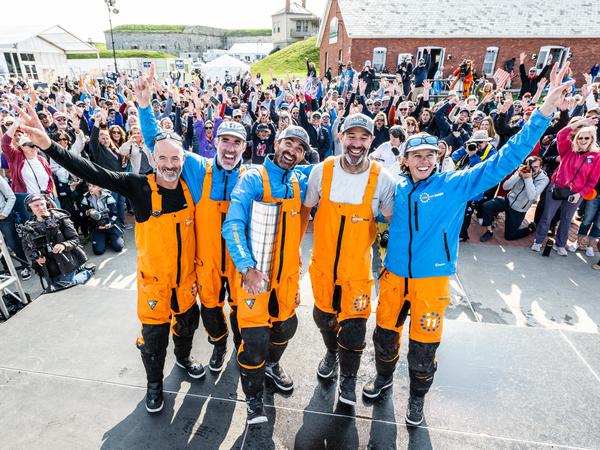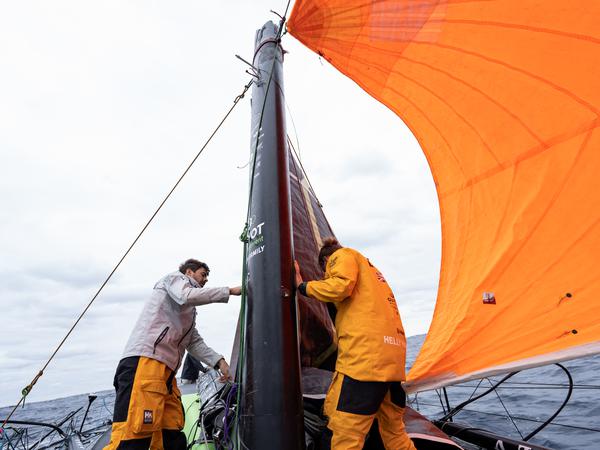When the “Malizia” loses the fourth stage of the Ocean Race, Boris Herrmann reassures the numerous supporters of his team with the declaration: “We lost 20 miles in bad clouds this morning. The team is fighting back.”
It is nevertheless the preliminary decision in a race that was fought out over long stretches as a duel – between the US team from “11th Hour” and the “Malicians”, as Herrmann’s colorful troupe calls themselves. The two Imoca racers sailed more than 5500 miles from Brazil to America within sight of each other, always with slight advantages for Herrmann’s boat, which started under the German flag, who, however, sat out this stage and ceded the role of skipper to his young partner Will Harris had.
The 29-year-old Brit did an excellent job in the duel with Charlie Enright, whose American team had so far not lived up to expectations. The fact that “Malizia” actually fought back was of no use in the end. 31 minutes after the stage winner, the “Malizia” crew arrived in Newport in second place. Which shows how little decides about victory or defeat with this level of performance. What can Harris do for “bad clouds”?
In the playbooks of the Ocean Race, the stage from Brazil to the USA traditionally does not play an important role. An in-between, a must-do, not the stage that brings triumph. The tropical weather, stuffy, hot and weakly winded, is mostly perceived by the sailors as a relaxation after the stormy crossing of the “Great South”, as the French call the Antarctic latitudes.
The cut-off grinder was quickly at hand
After the start in Itajai, things were once again going perfectly for “Holcim-PRB” when suddenly nothing was going at all. Kevin Escoffier and his fellow sailors were in the lead and made tack after tack to defend them when a fitting broke and the mast fell backwards like a felled tree, slamming onto the deck and instantly turning the beautiful order on board into total chaos. The cut-off machine was quickly at hand, and what was no longer usable on the mast was cut off. And first bobbed under the engine, then with the emergency rig in the direction of Rio, which was 160 miles away at the time of the accident.
This is how the flawless series of “Holcim-PRB” ended, who were able to collect 19 of the 20 points that had been earned up to that point. And it sent the first shock waves across the remaining fleet. Something can always break and break on racing yachts. But on older ones rather than brand new ones, as the case of “Guyot” on the previous stage showed. The fact that such an elementary attachment of the forestay could detach from the mast without being particularly heavily loaded by wind or sea gave room for the worst fears. The part is installed on all Imoca racers.
The failure of the 43-year-old dominator Escoffier, who was recently only beaten once by Boris Herrmann’s “Malizia”, in which a defective autopilot was not entirely uninvolved, gave his pursuers the chance to draw level on points. That spurred on both teams. In the end they were only eight miles apart. “We really wanted to beat them,” says “Malizia” sailor Rosalin Kuiper after arrival, “but they beat us and deserved it.”

Charlie Enright was clearly relieved at his success. The fact that he was the first to arrive in his hometown of Newport was a great satisfaction for the 41-year-old American, who was shaken by setbacks and technical problems and who has already participated in two ocean races. Especially since “11th Hour” is now tied for second place with “Malizia”, just one point behind “Holcim-PRB”. “This is a new start for us,” says Enright, with a view to the upcoming transatlantic, which will be counted twice.
“Guyot Environnement” suffered a severe setback when the mast of the European team broke on Tuesday night. The crew around skipper Benjamin Dutreux and with the German Robert Stanjek on board steered through a strong storm that the two leading yachts had already weathered by that time when the catastrophe occurred for reasons that are still unclear. Stanjek was lying in his bunk when he registered two “blatant stomps”. Then tumult broke out.

Dutreux didn’t want to believe it at first. “Oh, no, no,” he cried desperately, “no, please don’t.” But the fact was that the mast had fallen into the turbulent sea and had to be cut free as soon as possible.
At first Dutreux considered saving at least the mainsail they had set in the 3rd reef, but it was to no avail. The mainsail and two headsails were lost along with the mast, resulting in damage estimated at half a million euros.
Then I just heard… oh, the mast!
Robert Stanjek (42) after the accident
In a first statement, Stanjek is disillusioned and depressed by the incident. After a good start, the outsider team already had to deal with technical problems on the first stage, which threw them back a long way. Then important sails broke, so that one was no longer competitive. The South Sea stage had to be abandoned because parts of the hull began to disintegrate. And now the mast.
“I don’t know if you can always talk about bad luck. But what we did here didn’t feel wrong,” writes Stanjek of the “Yacht”. In any case, they would not have pushed the tube in 40 to 45 knots of wind from the SW, their priority was to survive the storm unscathed.
The loss 600 miles from Newport poses serious problems for the Franco-German team. It is questionable whether it can continue the Ocean Race. The Imoca class does have a replacement mast for such cases, but only one, and it is on its way to Newport to be placed on the deck of “Holcim-PRB”. Where a second mast will come from is unclear.
Another problem arises from the fact that Guyot still has a long way to go through the North Atlantic and Gulf Stream to reach the US coast. The boat can only do 3-4 knots under motor, so it will probably be a long time before the repair can begin, and so time is running out on the project, which was carried out with great effort by Berlin manager Jens Kuphal.
“We are now sailing the boat 20 percent faster than it should be in theory,” says “Malizia” skipper Harris once on the way. A steep learning curve is a prospect that makes such a race worthwhile even for those who don’t finish first. Can “Guyot” say the same about himself?
Stanjek & Co were knocked off very early. But now there is the feeling of being abandoned by your own boat.



